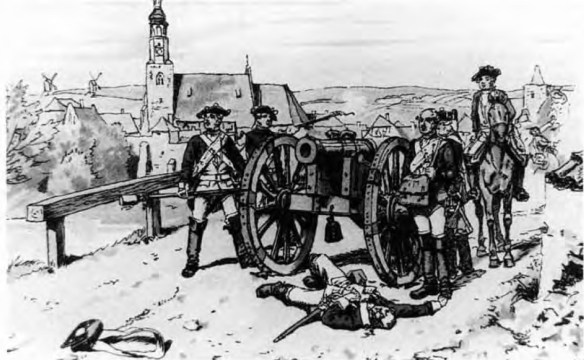Horse artillery in action during the Seven Years’ War. Crew-member no. 2 (second right), the loader, carries ammunition in a large leather satchel around the neck; no. 3 (second left) is about to ignite the charge by means of a portfire, no. 4, the aimer (right) having stepped clear of the path of recoil. The officer (mounted, rear) would normally command a section or pair of guns, although this duty could be undertaken by an NCO. (Print after R. Knotel)
Horse artillery guns and gunners, before the introduction of the cavalry plume in 1762. The officer (right) wears the waistcoat with laced edges common to all artillery officers, but his riding boots and turned-back coat skirts identify him as a member of the mounted branch. (Engraving after Menzel).
Frederick is often credited with the creation of the first mobile horse artillery, not intended primarily to support cavalry but to move rapidly across the battlefield to provide fire-support where necessary; but this branch was never independent, and remained small. Frederick the Great had been much impressed in 1757 with the performance of Russian horse artillery, particularly in the close fire support it had given to Russian cavalry. Two years later he introduced it into the Prussian service.
Despite his general indifference to the subject, Frederick nevertheless made a significant contribution to the advancement of field artillery. Owing to heavy casualties among his beloved infantry, Frederick found it increasingly necessary to compensate for their losses by increasing his artillery arm. In 1759 this situation eventually led to his introduction of the first true horse artillery units. These batteries, their entire crews furnished with mounts, were able to move more rapidly than any other artillery of the day and proved quite effective against the Russians during the Seven Years’ War. It was, however, typical of Frederick in his offhand treatment of his artillery that he did not fully recognize its potential or pursue the arm’s development beyond his immediate needs.
The first detachment, created in April 1759, comprised six light 6-pdrs and only 3 NCOs and 42 gunners; it was lost at Kunersdorf, and its ten-gun replacement battery was captured at Maxen. Prince Heinrich created his own battery (six 6-pdrs) in June 1759, and a replacement for the captured battery was formed in 1760. Both these units were disbanded after the Seven Years’ War, but by 1768 the horse artillery had been re-formed with twenty 6-pdrs and four howitzers. In 1773 Frederick created an artillery ‘Kommando’ in Potsdam for the training of horse artillerymen, the field strength being two ‘brigades’ of ten 6-pdrs and one 7-pdr howitzer, and the force had been enlarged sufficiently for it to take the field for the War of the Bavarian Succession with a strength of six batteries) each with eight 6-pdrs and a 7-pdr howitzer.
Whereas Frederick soon abandoned his horse artillery batteries, other European powers grasped the potential of the Prussian king’s invention and exploited it to their future advantage. As a result, by the time of the Napoleonic Wars, England and nearly every other Continental power fielded horse artillery batteries. Prussia had set the precedent for horse artillery with 6-pounders, but such other nations as Austria fielded 3-pounders and Denmark used diminutive 1-pounders—a striking contrast to the French 8-pounder guns and 6-inch howitzers.
